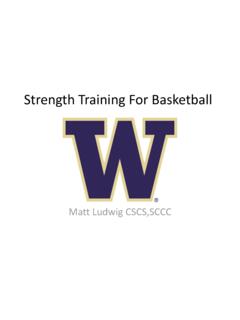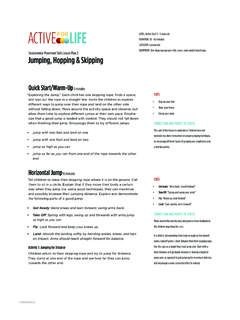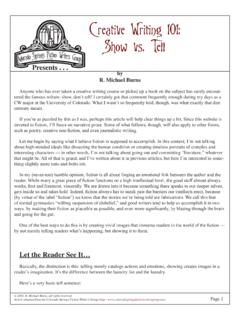Transcription of STRENGTH & CONDITIONING
1 STRENGTH & CONDITIONING County Academy Athletes STRENGTH & CONDITIONING England Netball s goal is to become and remain, the most consistently successful netball nation in the world. Encompassed within this is England Netball s vision to become the best physically prepared netballing nation. What is STRENGTH & CONDITIONING ? It is important to recognise that it is your responsibility to take your STRENGTH & CONDITIONING work seriously at an early stage of your netball career. You need to learn to become a better athlete as well as a netball player. A well rounded STRENGTH & CONDITIONING programme aims to develop the physical capabilities within an athlete so that they can continually train at a level that will allow netball athletes existing in and entering the Performance Pathway to achieve the physical and technical skills required to play senior level netball for England.
2 THE STRENGTH & CONDITIONING PERFORMANCE PLAN Senior Athletes Speed Power STRENGTH STRENGTH & CONDITIONING in netball focuses on 4 key areas. This diagram represents the shift in importance of these 4 components as you move through the Performance Pathway. All of these components are important for your development as an athlete but at the moment, the majority of your work should be focussed on injury prevention. Satellite & County Our aim is to develop an athlete that is resilient to injury and has the physical qualities required for high performance netball. You can read about the type of training required for this in more detail in the following sections.
3 Injury Prevention WHAT DOES S&C TRAINING DO FOR ME? INJURY PREVENTION Keeping you on the court is the primary concern of the STRENGTH and CONDITIONING coach. If you are injury free then you have greater time to spend with your Technical Coach and have greater chances of making technical improvements on the court. It is important that you learn how to activate key muscle groups that stabilise your hips (glutes) and torso (spine and abdominals) so that you move efficiently, and are able to hold the strongest positions body positions when on court. Injury prevention can be broken down into two main areas: 1. Activation These exercises switch on the key muscles that are will help prevent injury and improve your performance on court.
4 How often? These exercises should be done at least 4 times per week but ideally every day. When? These exercises should be performed before you start your Netball sessions at the very beginning of your warm up. If you are not playing on a given day find time to complete these exercises at home all you need is a floor! If you are playing other sports you should also perform activation prior to starting- if you are preventing injury and improving your performance then you know it makes sense. Ask your Academy Coach to show you how to perform activation exercises safely and most importantly effectively. Remember that excellence is a habit, not an act- so get practicing!
5 Figure 1. The Glute Bidge Start Finish 2. Landing Skills Your ability to land safely and effectively in a variety of ways within steps can dramatically reduce your risk of injury and improve your on court performance. Landing well will protect areas at risk of injury such as the knee and the ankle as well as improve your ability to stay upright to see the players and court around you which will enable you release the ball faster to your team mates, make an interception and set the base for you to change direction for the next play! How often? These exercises should be performed 4 times per week after you have finished a set of activation exercises.
6 When? These exercises should be performed prior to every netball session after you have performed your activation exercises. If you are going to be running, jumping , and landing at a high intensity during a netball session it is crucial that you have switched the right muscles on (activation) so that you can control your body in space and stop effectively in the strongest and most efficient postures (landing skills). The quality of your execution of landing is very important and you must earn the right to progress to the next level based on your ability. Your coach will put you through a series of netball readiness tests. The results of these tests will dictate which landing skills programme you perform.
7 There are 4 levels of the landing skills programme within the Academy structures. Each level becomes progressively more challenging as your athletic ability improves. The hop and stop' test is an indicator of which level you should be completing. Figure 2. The Hop & Hold Test Start position Transition Hop Hold STRENGTH & POWER STRENGTH development is important as it increases your ability to produce force both statically (from standing still) and dynamically (on the move) as well as resisting forces placed upon the body. Being able to produce a high amount of force increases your ability to run, jump, land and change direction and reduces risk of injury.
8 The biggest goal of your STRENGTH training at this stage is to increase the local muscular endurance of areas that are at risk of injury and keep you on the court. STRENGTH TRAINING TERMINOLOGY- WHAT DOES IT ALL MEAN? Rep: A rep is one unit of work for a given exercise. If your STRENGTH & CONDITIONING programme lists an exercise as 12 reps you would do 12 units of work. Set: A set is a group of reps. If your STRENGTH & CONDITIONING programme lists that you must do 3 sets of 12 reps then you would do 12 reps, rest the appropriate amount, and then repeat until you have done 3 groups of 12 reps. Rest: The rest period between sets is very important as it ensures that your muscles have adequate recovery to complete high quality work during the next set.
9 STRENGTH training is taxing on the body and you should be able to do no more than 20 reps per set. If you can do more than 20 reps of a specific exercise with optimal technique then speak to your coach about how you may progress that exercise. It is important that you are able to control your own bodyweight effectively and safely before loading yourself with equipment such as bands, med balls, dumbbells, and barbells. You must earn the right to progress exercises based on your physical and technical competence. Power is the product of force and velocity (Power= Force x Velocity) or the product of STRENGTH and speed (Power = STRENGTH x Speed). It is important at this stage of your development to achieve a good level of Force/ STRENGTH so that you are able to apply this high force quickly and so improving your power output!
10 Performing exercises like jumps, hops, and leaps allow you to practice applying your force quickly and improve your power output. How often? STRENGTH training should be conducted twice per week. When? You have 2 main options for ordering when to do your STRENGTH training. These are dependent on how organised you are. If you re smart about it you will be able to maximise the benefit that that you are getting from your STRENGTH training. STRENGTH & POWER Option 1: Prior to netball training You should always be in a none-fatigued state prior to your STRENGTH & power training to get the greatest benefit from it. STRENGTH training prior to netball training has the potential to increase the activation of the muscles in the key areas of the body to that will enable to you to land, change direction, and jump more effectively.













